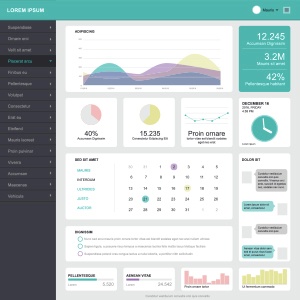 Dashboards enable healthcare organizations to assess their overall status by providing them with key analytics and replacing the need to review several, detailed reports. They can be utilized to track revenue cycle performance, help meet meaningful use standards and monitor disparate processes for more efficiency. Furthermore, dashboards can integrate with electronic workflow management solutions and identify areas for operational, financial and quality of care improvements.
Dashboards enable healthcare organizations to assess their overall status by providing them with key analytics and replacing the need to review several, detailed reports. They can be utilized to track revenue cycle performance, help meet meaningful use standards and monitor disparate processes for more efficiency. Furthermore, dashboards can integrate with electronic workflow management solutions and identify areas for operational, financial and quality of care improvements.
Mobile dashboards provide even more benefits for healthcare providers through real-time access to actionable, accurate and accessible data. Furthermore, dashboards offer an intuitive and convenient method for clinicians to access necessary information anytime at any place, thereby improving patient care. Following are five steps for healthcare organizations to take when creating or designing a new dashboard.
1. Provide a clear picture using visualizations.
The goal of healthcare dashboards is to convey relevant information to leadership and clinicians in a visually rich, easy to understand format. Many dashboards include healthcare data analytics visualizations, which provide a way to communicate quantitative data in a way that is accessible and easy to understand. Dashboards that are too complex can make it difficult for users to view, thereby decreasing their ability to share information with others throughout their healthcare organization.
2. Promote user involvement and include user input.
Incorporating user input into a dashboard design not only helps gain buy-in but also ensures that the included KPIs benefit the healthcare organization as a whole. In addition, by working with clinicians to establish clear ownership for specific tracked measures, the correct data needs are met.
3. Combining relevant data from multiple sources.
All of a healthcare organization’s relevant data should be utilized in a dashboard. It should be integrated to offer a single, unified view of the organization’s financial, clinical and/or operational performance.
4. Select the correct metrics.
KPIs enable healthcare organizations to analyze real-time data to provide insight into their clinical, operational and financial performance. They allow providers to drill down into data to identify and eliminate root causes for poor performance and make proactive decisions accordingly.
Dashboards should include a manageable number of metrics, and those that are selected should highlight a healthcare organization’s quality of care, financial status and operational efficiency. They should provide the capability for specific users to drill down to more detail if necessary.
5. Enable secure and convenient access to your dashboards.
Healthcare dashboards must include security measures to comply with government guidelines such as HIPAA. They must convey patient information without wrongly distributing projected health information. In addition, those within a healthcare organization who are given permission to use dashboard should have easy access to it.
Learn More
Syntrix Consulting offers pre-built healthcare dashboards that let you start analyzing operations without delay and allow you to keep an eye on the big picture while focusing on what matters most. With our pre-built dashboards, proprietary BI Portal and customizable solutions, we can support all your data analytics needs. Contact us to learn more.
For more information about healthcare analytics, Epic reporting, and how to have a successful implementation, download our FREE eBook:
